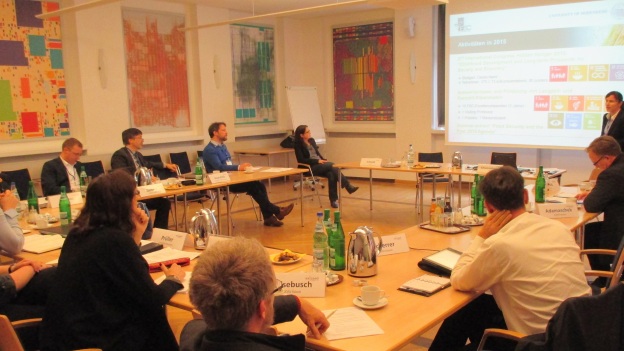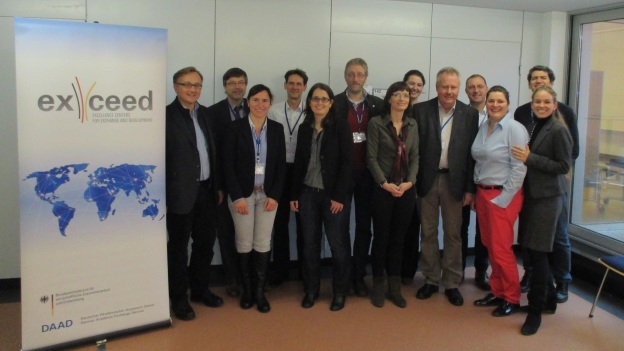Sustainable development cooperation
 DAAD
DAAD
Focus on exchange and networking: Common aims for the sake of sustainability
The networks of the “exceed” centres set up by the DAAD with funds from the Federal Ministry for Economic Cooperation and Development (BMZ) are highly international and active in four continents. They also play a significant role in implementing the United Nations’ new sustainability goals. A network meeting of the exceed centres in Bonn provided an opportunity for an exchange of information by the project partners and focussed on the topic “Causes of Migration”.
A consensus was reached after two days of constructive collaboration: the causes of migration and megacities should form the focus of cooperation within the exceed network in the next five years. The meeting on 30 November and 1 December at the DAAD in Bonn marked the start of the second phase of the exceed programme. “The dynamic development is great,” says the programme manager responsible at the DAAD, Julia Schwarzenberger. “Aims of the second funding phase include a more targeted identification of synergy effects and increased utilisation of these.”
In 2009, the DAAD issued a call for proposals for the exceed programme: higher education excellence in the development cooperation was to be strengthened, bundled and rendered more visible to the public. The Federal Ministry for Economic Cooperation and Development (BMZ) provides five German universities with annual funding of €1 million each to set up research projects and study programmes for Master’s and PhD students in cooperation with partner institutions in developing countries. During the first five years of the programme, the primary aim was to set up the centres and enable them to establish networks with the partners in the developing countries. “We are working with 29 partners in 15 countries on four continents,” says Andreas Haarstrick, for example. He is a professor at a centre of the International Network on Sustainable Water Management in Developing Countries, abbreviated as SWINDON. The other institutions are also active in at least three continents. The second project phase, intended for the exceed institutions to strengthen their ties amongst each other by 2019, is now starting. How the cooperation could be improved in future is illustrated by the following example: two partners organised very similar events in Vietnam shortly after one another last year. It was agreed at the network meeting in Bonn that a joint event should be held instead in 2016. Combination of the complementary contents of the two networks will create added value for both partners.
Resource management – and much more
The five centres have been selected to complement one another thematically. Haarstrick’s SWINDON at TU Braunschweig considers for example how people may be reliably supplied with water, how to dispose of wastewater and how to protect against too much water. The four other centres contribute to teaching, research and knowledge transfer in the developing countries with regard to the subjects of resource management, humane work, food security and medicine.
The participants based their planning for the coming years on the UN’s new sustainability goals. The 17 Sustainable Development Goals (SDGs) of the 2030 Agenda replace the eight goals of the UN’s millennium campaign that ended this year. Fighting poverty and hunger, improving the quality of life and infrastructure, providing employment, clean water and education – all these sustainability goals are taken into account in the updated projects. Goal 17 seeks at linking the goals: there is to be a more intensive exchange between the industrialised nations, emerging countries and developing countries on science, technology and innovation to make sure that all the goals are reached by the sustainable cooperation. The exceed programme addresses precisely this area and facilitates new approaches.

DAAD
The exceed team: Coordinated contribution to the SDGs
Analysing causes of migration
Lars Gerold, who heads the section Institution Building in Higher Education at the DAAD, considered the network meeting a success: “We have set up a joint work plan and concrete goals oriented towards current issues in development cooperation.” Take the causes of migration for example: coordinated by the Centre for International Health at the Ludwig Maximilian University Munich (LMU) researchers aim to analyse the causes of flight on location and contemplate solutions in cooperation with their partners in the respective countries. Supported by the DAAD, the exceed centres want to host an expert workshop on the causes of migration in October 2016 and present preliminary findings at a scientific symposium. This is to be followed by a summer school for Master’s and PhD students in 2017.
With regard to megacities, the participants above all saw common ground in the areas of social housing, health and wastewater in which they can cooperate more intensively in the future. The Centre for Natural Resources and Development at Cologne University of Applied Sciences has already started to prepare a curriculum for an interdisciplinary Master’s programme in cooperation with the Ain Shams University in the Egyptian capital of Cairo.
The subject of sustainability also affects the exceed centres themselves. They are to make themselves indispensable at their own universities in the coming five years. This is aided by the fact that the universities wish to enhance their profiles in the field of development cooperation. And yet: “Despite all the positive signals from the universities, it remains a lengthy process,” emphasises Lars Gerold: “Long-term establishment of sound institutional structures at the universities requires a lot of political effort on many different levels.”
Joachim Budde (14 January 2016)